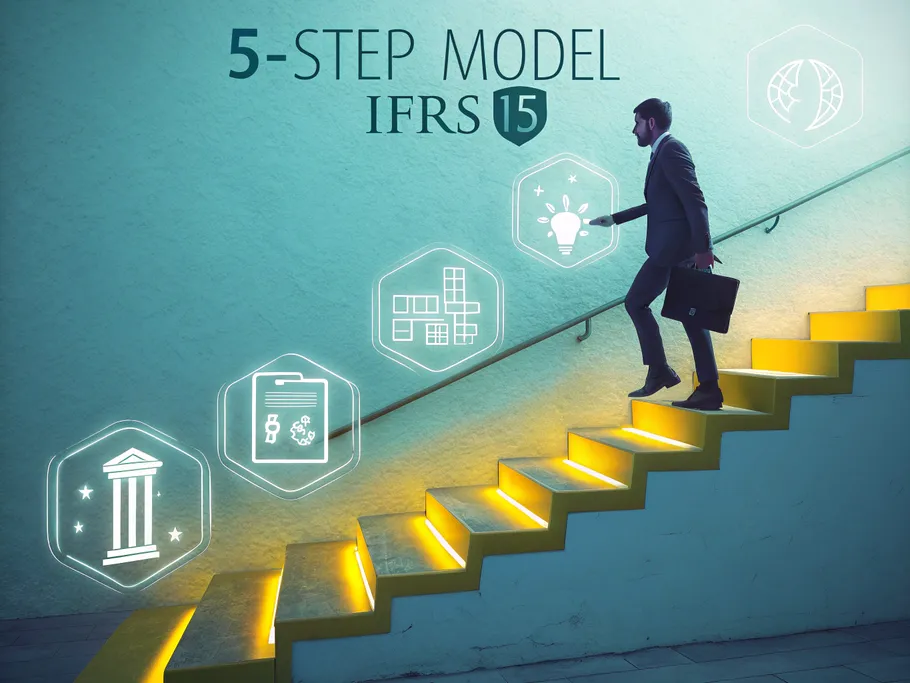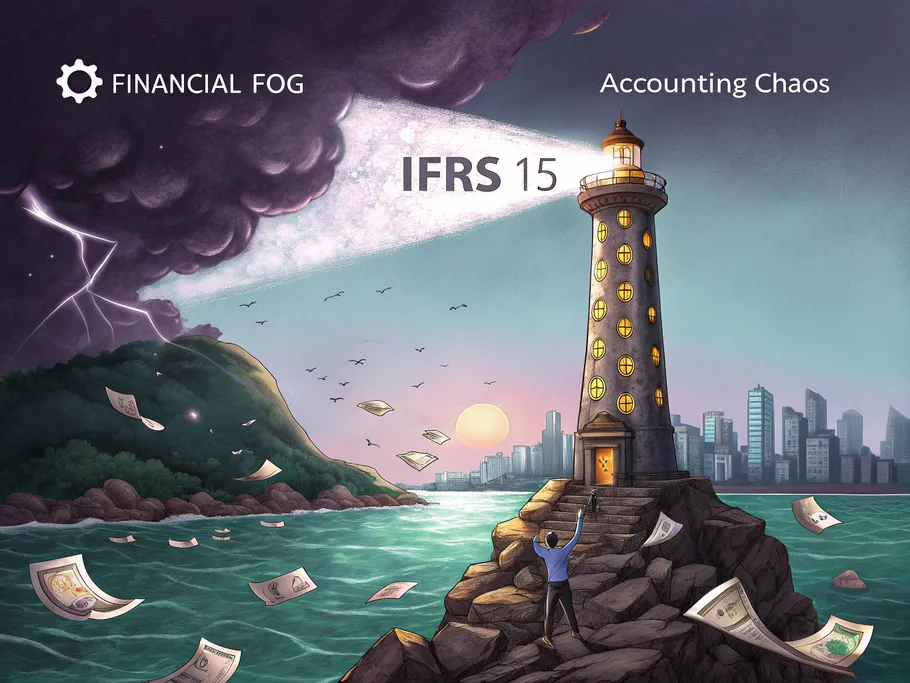Alright, let’s talk about money. Specifically, how you account for it. If you’re tired of dense textbooks that could sedate a rhino, you’ve come to the right place. This guide breaks down the core revenue recognition principles under IFRS into simple, digestible terms. We’ll cover the basics and walk through practical examples you can apply to your business. Let’s untangle International Financial Reporting Standards (IFRS) without the usual headache.
From Chaos to Clarity: Why Revenue Recognition Actually Matters
Ever feel like your business’s income is on a wild rollercoaster? One month you’re making it rain, the next you’re checking the couch cushions for spare change. You’re not alone. For many businesses, unpredictable income makes planning and growth feel like nailing Jell-O to a wall.
This is where proper revenue recognition steps in. It’s the secret sauce that brings clarity and control to your financial chaos. Under IFRS, you recognize revenue when you’ve earned it by delivering the goods or services, not just when the cash lands in your bank account. This gives you a true and fair view of your financial performance.

Think it’s just a bureaucratic hoop to jump through? Think again. A study of firms in Australia and New Zealand found that for 36.62% of them, adopting IFRS 15 led to notable changes in their financial statements. This isn’t just about ticking boxes; it’s a strategic move that ensures transparency, enables better decision-making, and makes your business healthier and more predictable.
Decoding the Jargon: Key Terms Without the B.S.
Let’s cut through the noise. You need to know these five terms to get a grip on IFRS 15 revenue recognition.
- Contract: An agreement that creates enforceable rights and obligations. And no, it doesn’t have to be a 50-page document written in blood. It can be a formal paper, an online order, or even a verbal agreement, as long as it’s clear you’re getting paid.
- Customer: The hero of our story—the party paying you for your awesome goods or services.
- Performance Obligation: Each distinct promise you make in a contract. If you sell a phone bundled with a year of cloud storage, you have two performance obligations. You have to deliver the phone, and you have to provide the storage.
- Revenue: The income your business generates from its main gigs. This is your lifeblood.
- Transaction Price: What you expect to get paid for fulfilling your promises. This excludes things you’re just collecting for the government, like sales tax.
IFRS 15: Your Roadmap to Sanity
IFRS 15, officially titled “Revenue from Contracts with Customers,” is the master key. It replaced a whole mess of older, confusing standards with a single, principles-based framework. Its goal is to make financial reports more consistent and transparent across all industries. The heart of it all is the 5-step revenue recognition model.
The 5-Step Revenue Recognition Model: A Practical Guide
This model ensures your revenue reflects the actual transfer of goods or services to your customers. Here are the steps:
- Identify the contract(s) with a customer.
- Identify the performance obligations in the contract.
- Determine the transaction price.
- Allocate the transaction price to the performance obligations.
- Recognize revenue when a performance obligation is satisfied.
To make it foolproof, use this checklist to understand the criteria for revenue recognition.
Revenue Recognition Checklist
- Step 1: Contract Identified?
- [ ] Agreement approved by all parties
- [ ] Each party’s rights identified
- [ ] Payment terms identified
- [ ] Contract has commercial substance
- [ ] Probable collection of consideration
- Step 2: Performance Obligations Spotted?
- [ ] All promised goods/services listed
- [ ] Goods/services are distinct
- [ ] Promises are separately identifiable
- Step 3: Transaction Price Calculated?
- [ ] Fixed consideration amount
- [ ] Variable consideration assessed
- [ ] Significant financing component considered
- [ ] Non-cash consideration reviewed
- Step 4: Price Allocated?
- [ ] Standalone selling price for each obligation determined
- [ ] Total price allocated proportionally
- Step 5: Revenue Recognized?
- [ ] Control transfers over time or at a point in time determined for each obligation
- [ ] Revenue recognized as each obligation is satisfied
Step 1: Identifying the Contract
A contract exists when there’s a legally enforceable agreement. This could be a written document, an online order, or even a verbal agreement—provided it’s probable that you’ll actually collect the payment.
Step 2: Spotting Performance Obligations
Next, identify each distinct promise in the contract. A performance obligation is “distinct” if the customer can benefit from it on its own and it’s separable from other promises. For example, selling a smartphone bundled with a year of cloud storage involves two performance obligations because the customer can use the phone without the storage, and vice-versa.

Step 3: Calculating the Transaction Price
Determine the total amount you expect to receive. This isn’t always a flat fee. You need to account for any discounts, rebates, refunds, or performance bonuses. If payment terms stretch out over a long time, you might also need to adjust for any significant financing components.
Step 4: Allocating the Transaction Price
Now, slice up that total price. Allocate it to each separate performance obligation based on their relative stand-alone selling prices. If you don’t sell them separately, you’ll have to make a reasonable estimate.
Step 5: Recognizing Revenue
This is the moment of truth. You recognize revenue when control of the goods or services passes to the customer. This happens either over time or at a specific point.
Revenue recognition over time vs point in time
- Over Time: You recognize revenue as you go. This applies when the customer receives and consumes the benefits as you perform the work (like a monthly subscription service) or when you’re creating an asset that the customer controls as it’s being built.
- At a Point in Time: You recognize revenue all at once. This is for when control is transferred at a specific moment—typically upon delivery, when legal title transfers, or when the customer formally accepts the goods.
Examples of Revenue Recognition in Action
Here are some real-world IFRS 15 revenue recognition examples.
Service Provider Example ABC Company contracts with Mr. Peter to provide a custom-made kitchen cabinet for $3,000, which includes delivery and installation. The standalone market prices are: delivery $200, installation $200, similar custom.-made cabinet $2,800.
- Performance Obligations: 1) Cabinet and the installation, 2) Delivery.
- Transaction Price: $3,000.
- Allocation: If the cabinet sells for $2,800 alone and installation for $400, you’d allocate the $3,000 proportionally.
| Performance obligation | Standalone price | Percentage | Allocation of the transaction price of $3000 |
|---|---|---|---|
| Delivery of kitchen cabinet | $200 | ($200 / $3,200) x 100= 6.25% | $3,000 x 6.25%= $187.5 |
| Kitchen cabinet and installation | $2,800 + $200 = $3,000 | ($3,000 / $3,200) x 100= 93.75% | $3,000 x 93.75%= $2,812.50 |
| TOTAL | $3,200 | 100% | $3000 |
- Revenue Recognition: Revenue for the cabinet is recognized on delivery. Installation revenue is recognized when the job is done.

Common Revenue Recognition Pitfalls and How to Sidestep Them
It’s easy to get this wrong. Common mistakes include misidentifying performance obligations, botching estimates for variable consideration, getting the timing wrong, or ignoring contract modifications.
For instance, a software company that bundles setup and training with its product might improperly recognize all the revenue upfront, instead of separating each service and recognizing the revenue as each part is completed.
When navigating complex tasks, it’s natural to feel concerned about making mistakes. Taking the time to be precise and breaking down what feels overwhelming can help guide you through. It’s also wise to lean on support or ask for clarity when you need it.
To avoid errors:
- Diligently identify all performance obligations.
- Properly estimate variable consideration.
- Recognize revenue only when control actually transfers.
- Re-evaluate contracts whenever they are modified.
Implementing strong internal controls and training your finance team is crucial. When in doubt, call in a professional for complex contracts.
Beyond the Basics: Advanced Scenarios
Some situations require a closer look:
- Contract Modifications: Changes might be treated as a brand-new contract or a modification of the existing one.
- Variable Consideration: This includes bonuses, penalties, and discounts. You must estimate these amounts conservatively to avoid having to reverse revenue later.
- Principal versus Agent: Are you providing the service (principal) or just arranging it for someone else (agent)? This determines whether you report the gross revenue or just your net commission.
For these tricky cases, seek expert advice or dive into the full IFRS 15 text.
IFRS 15 and the Digital World
IFRS 15 has specific implications for tech businesses:
- Subscription Models (SaaS): Revenue must be recognized over the subscription period, not all at once when the customer pays.
- Software Licensing: Recognition depends on whether the license is a right to use the software as-is (recognize upfront) or a right to access it with ongoing updates (recognize over time).
- Online Marketplaces: You must determine if you are the principal or an agent to know whether to report gross revenue or only your commission.
IFRS 15 vs. US GAAP: What’s the Difference?
Good news: IFRS 15 and its US GAAP counterpart, ASC 606, are mostly aligned and use the same 5-step model. However, minor differences exist in areas like accounting for contract costs and some specific types of license revenue. If you report under both standards, you’ll need systems to manage these distinctions.
The Future of Revenue Recognition
As technology evolves with AI services, blockchain contracts, and new subscription models, revenue recognition challenges will continue to emerge. Regulators will adapt, but the core principle remains timeless: recognize revenue to reflect the transfer of promised goods or services in an amount you expect to receive.
Takeaways
Mastering IFRS 15 revenue recognition isn’t just about compliance; it’s about gaining financial clarity. By understanding the 5-step revenue recognition model and the nuances of your business, you can build a foundation for accurate reporting and sustainable growth.
